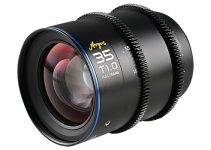If I had to pick the three most exciting cinema camera launches of 2020 I would go with the Sony FX6, Canon C70, and RED KOMODO. Easy choices. All of these cameras also share a design ethos of being small and lightweight while offering image quality and features normally found in larger, pricier systems. Those are just about the only things that are similar between them.
Being the most recent, the FX6 is the shining star of the cinema world, though it faces stiff competition. CVP had 48 hours with the FX6 and threw up some great tests to show if it holds up against the KOMODO, C70, and FX9.
Jake Ratcliffe is once again our CVP host for another in-depth camera test. And, we have to start by going over the weirdest thing about the FX6 (and the a7S III): what is/are the native ISO(s)?
As Ratcliffe explains, the FX6 doesn’t have a true dual base ISO capability, but it does has a high-sensitivity mode that functions in a very similar way.
With a real dual base ISO, there should be effectively no difference in noise and dynamic range when switching between the two settings. However, on the FX6 and a7S III, there is going to be a slight difference with the high-sensitivity mode offering less dynamic range and showing additional noise in some scenarios.
The a7S III operates in a very similar manner, but interestingly it is not the same. The a7S III uses a bit more noise reduction, even when the options are turned off and to their lowest setting in the camera’s menu. This makes some sense for a consumer-facing product.
Being a more traditional cinema camera, the FX6 appears to provide a more “raw” image with minimal noise reduction applied. It’s nice to see. It’s confusing, though Sony is obviously trying to warn people that switching to the high settings is still going to show a bit more noise. Practically speaking, however, the FX6 still has impressive low-light performance.
Now for the first comparison: underexposure. For the testing, they put the FX6 against the FX9, KOMODO, and C300 Mark III—more on this in a minute.
Codecs were XAVC-I on the Sonys, R3D HQ on the KOMODO, and XF-AVC for the C300 Mark III. As the C70 is the better comparison and both cameras share sensor technology, CVP decided to limit Canon to XF-AVC as it is the top codec available on the C70.
Under/overexposure tests were metered with false color on a Shogun 7, and then the exposure was kept consistent between the cameras. They also used the ZEISS Otus 55mm as their lens.
Under exposure with the FX6, at both “base” ISO options, seems to hold up very well up to 4 stops. Beyond that it gets very noisy. Five stops and up becomes almost unusable.
The FX9 starts to shift green when underexposed and has less chroma noise reduction. The C300 shift magenta and struggles to maintain color accuracy. KOMODO has decent color but gets very noisy and shifts green the more underexposed you get.
Over exposure showed that up to +4 stops the FX6 seems to hold on well. It is right here things start to change as 5 and up it gets bad. The FX9 showed very similar performance. The C300 was also similar with a little worse color. RED holds color very well, but at 5+ the skin breaks very badly.
ISO was up next and the FX6 is looking to be a top performer. It holds on in both low- and high-sensitivity modes with no real differences for the in-between ISOs. There also seems to be some chroma noise reduction that helps it look a bit better straight out of camera.
It is definitely better than the FX9, which remains usable up to about ISO 25600 with noise reduction in post. Canon and RED don’t hold up in low-light performance. Canon is usable up to ISO 6400/12800 while the KOMODO is limited to just ISO 1600 or maybe 3200. Impressive work by Sony here.
Moving on to slow motion, the FX6 has outstanding specs here. It’ll do 4K at up to 120p or Full HD up to 240p. Rolling shutter is also very good. However, it is important to mention that RED offers a global shutter on the KOMODO. The ND system on Sony is great still. It’s the electronically controlled version we have seen on many recent releases and perfectly smooth. Hard to beat it.
Raw video is possible with the FX6 via the 12G-SDI output to an Atomos Shogun 7. It works right out of the box without issue. You’ll have to record in ProRes RAW or ProRes RAW HQ, which is fortunately growing in support. Though you will need Final Cut Pro X to get features like ISO metadata and control. Standard codecs include XAVC-I and XAVC-L in DCI 4K, UHD 4K, and Full HD. Full-frame options are available for all, but only Full HD is available in both full-frame and Super 35mm.
A fun feature we have been seeing recently is gyro metadata being used for post stabilization. It essentially records the movement information and then Catalyst Browse software applies the stabilization based on that movement. However, the need to use another program limits its functionality in existing workflows. Plus, it can be hit or miss.
Clear Image Zoom is another Sony-specific feature. It allows you to digitally zoom in on the image with smart upscaling to preserve details. It’s a useful feature and can help maintain 4K resolution even when using Super 35mm lenses.
Audio is fairly standard. Good preamps and XLR inputs help you work with most pro microphones. However, the inputs are only available on the top handle. If you aren’t using the top handle you lose your pro inputs. The camera also won’t record audio in the Slow & Quick Motion modes.
Using it for run-and-gun filmmaking at night the folks at CVP found the FX6 to be a great option. Though there is some noise that shows up at ISO 12800 and above. The next day they shot out in the rain and the camera performed well.
Considering the noise reduction can be turned off you’ll have to do your denoising in post. The recommendation is to actually use a little bit of noise reduction and then do the rest using whatever tool you normally use during editing.
Using a bigger battery is a major advantage of a cinema camera, and using the BP-U series means you can get great battery life. The FX6 in particular has a lower power draw of 18W, and the BP-98UX batteries they used provided over four hours of runtime. It helps to not have to carry tons of big spares all day.
Finally, we have to mention the color profiles. All of Sony’s expected options are here, such as S-Log3, but the great addition is S-Cinetone like in the FX9. This profile is great to start and will make it easy to match the FX6 with the FX9 or even a VENICE.
The reception of the FX6 is overwhelmingly positive. The FX6 has excellent image quality, is among the top cinema cameras in low light, and has good AF performance. It holds its own against all the competition easily.
Are you considering the FX6 as your next camera?
[source: CVP]
Order Links:
- Sony FX6 Digital Cinema Camera (B&H, Amazon)
- Canon EOS C70 Digital Cinema Camera (B&H)
- RED KOMODO 6K Digital Cinema Camera (B&H)
- Sony FX9 Digital Cinema Camera (B&H)
- Atomos Shogun 7 Monitor/Recorder/Switcher (B&H, Amazon)
Disclaimer: As an Amazon Associate partner and participant in B&H and Adorama Affiliate programmes, we earn a small comission from each purchase made through the affiliate links listed above at no additional cost to you.




